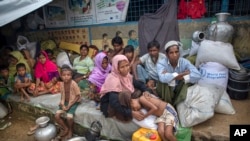U.N. agencies say bad roads and bad weather are compounding the difficulties of delivering essential aid to hundreds of thousands of Rohingya refugees living in small, congested areas in Bangladesh.
The International Organization for Migration reports more than 800,000 Rohingya refugees are living in Cox’s Bazar. More than 600,000 have fled Myanmar over the past two months. The others have arrived there following previous outbreaks of violence in Myanmar.
IOM spokesman Joel Millman says most new arrivals are living in crowded makeshift settlements. He says the heavy rains and other logistical obstacles are making it difficult to deliver the materials and relief supplies shipped to the region to the people who need it.
He says more roads and basic infrastructure, such as drains and stairways, must be built to make sure the refugees can receive services as quickly and effectively as possible.
“For example, 741,000 liters of water have been trucked into the settlements with limited access to water. … This has to be carried up steep hills to be close to the elderly and children, who might otherwise not get access to it,” Millman said.
Millman says the refugees arrive with little or no possessions. He says they have no means of building a shelter that is livable and can protect them from bad weather. He says the IOM has provided many thousands of shelter kits to help families.
“Medical needs in the camps are extremely high, especially considering that many of the refugees would have walked long distances to reach Bangladesh, with many having experienced physical and sexual abuse along the way, and now are living in over-crowded sites that were not ready for habitation by over 800,000 people,” Millman said.
Millman says the IOM has set up emergency and primary health care services for 53,000 patients. He says a child-delivery facility and a patient-stabilization unit are available for the many Rohingya refugees living in the large Kutupalong camp.










